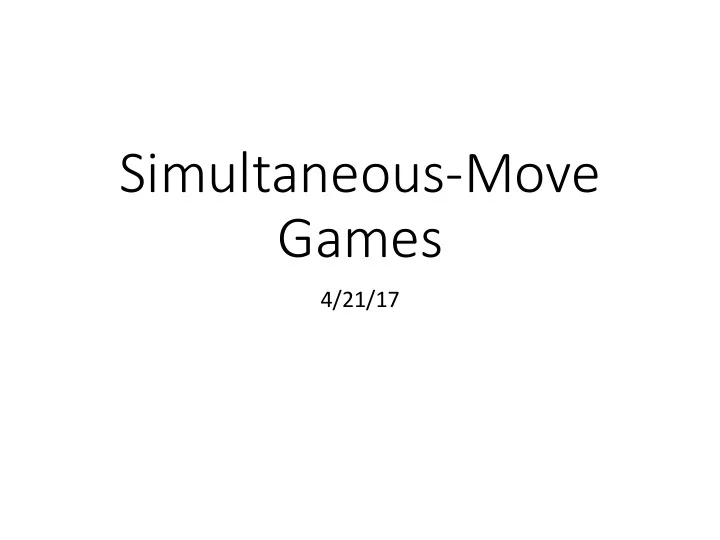

Simultaneous-Move Games 4/21/17
Recall: Game Trees 1 3,0 0,3 2,1 1,2 2 2 2 2 A R A R A R A R 3,-.5 2,.5 0,0 -.5,3 0,0 0,0 .5,2 0,0 • Agents make decisions sequentially. • Outcomes (leaves) have a utility for each agent. • Solve by backward induction. Good for modeling: • Classic board games (connect four, hex, etc.) • Discrete time interactions (resource sharing, deterrence)
Simultaneous Moves What if agents make decisions at the same time? • Rock-paper-scissors 2 R P S R 0,0 -1,1 1,-1 1 P 1,-1 0,0 -1,1 S -1,1 1,-1 0,0 normal form game • payoff matrix •
Navigation Example (sequential) A B
Exercise: Construct a game tree. Available actions: Up, Right Up, Left Timing: short path: 30s 45s long path: 40s 60s conflict: adds 20 seconds to both
Navigation Example (simultaneous) A B
Exercise: Fill in the payoff matrix. Convention: Row player’s utility first. U L U R Bonus question: what if a conflict only costs 5s?
Nash Equilibrium • An outcome where no agent can gain by unilateral deviation. U L U L U U -60,-80 -40,-45 -45,-65 -40,-45 R R -30,-60 -50,-65 -30,-60 -35,-50
Identifying Nash Equilibria for each cell in the payoff matrix: for each player: for each deviation: if deviation > strategy: cell is not a NE if no beneficial deviations: cell is a NE D E F A 9,3 1,4 7,3 B 4,1 3,3 6,2 C -1,9 2,8 8,-1
Dominated Strategies If strategy X is always better than strategy Y , then Y can be eliminated from the game. D E F Exercise: A 9,3 1,4 7,3 Iteratively eliminate dominated strategies until no more dominated B 4,1 3,3 6,2 strategies remain. C -1,9 2,8 8,-1 After one strategy is eliminated, others may be dominated in the game that remains.
Pursuit/Evasion Example
Exercise: Construct a payoff matrix. Available actions: Left, Right Left, Right Incentives: +5 catch:+1 +3 miss: −1 0
Exercise: Identify all Nash equilibria. L R L 0,1 5,-1 R 3,-1 0,1 • There are no pure-strategy equilibria! • We need mixed strategies • Agents should deliberately randomize their actions
More than two agents • Add more dimensions to the array. • Add more utilities to each outcome tuple. Player 1 u 1 ,u 2 ,u 3 Player 2 In a game with N agents that each have S actions, how many utilities does the payoff matrix contain?
Recommend
More recommend